Health
The Artesian Tree
I can find no fuller account of this miracle. No doubt it was bulldozed long ago.ADDENDUM: I just did the obvious and visited the address given via Google Streetview. No sign of the fabled tree, alas. See screenshot in extended.
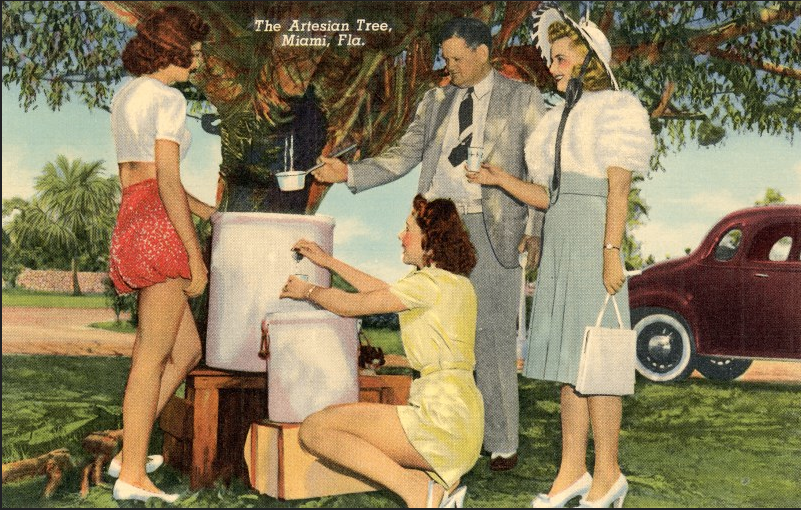

More in extended >>
Posted By: Paul - Sat Jan 15, 2022 -
Comments (4)
Category: Health, Regionalism, Natural Wonders
The Patented Carrot Rectal Dilator
In 1927, the Canadian patent office granted an unusual patent (CA 259317) to George L. Kavanagh. It was unusual because, while most patents describe some new type of gadget or gizmo, Kavanagh's invention simply consisted of a method of using a carrot.The problem Kavanagh had set out to solve was that of constipation in the elderly. The way he saw it, our rectums tend to grow more inelastic and shrunken as we age, and this leads to constipation. The solution, he concluded, was "gently dilating the anus and rectum until the organs are restored to their youthful size."
But what could be used as a dilator? Preferably something inexpensive and readily obtainable. That made him think of carrots.
A summary from his patent:
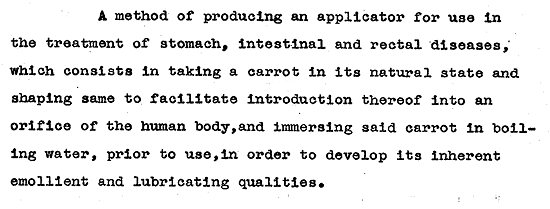
An added benefit of carrots, he noted, was that they come in a variety of different sizes. This would allow one to start with small carrots and work up to larger ones "until the desired result is obtained."
Unfortunately, Kavanagh submitted no drawings with his patent. But I did find a chart that provides a size comparison of different types of carrots, which could be potentially useful for anyone who wants to try out Kavanagh's method at home on an elderly relative.

image source: 123rf.com
Update: Kavanagh also got a US Patent (No. 1,525,505) for his invention.
Posted By: Alex - Wed Nov 24, 2021 -
Comments (3)
Category: Health, Inventions, Patents, Vegetables, 1920s
Device to prevent mouth breathing
In 1920, Richard Jefferies was granted a patent for "a simple and practical device which will eliminate the habit of breathing through the mouth and at the same time will assist in harmonizing the facial features of the wearer, by more evenly balancing the muscles of expression."His invention consisted of a piece of adhesive-backed silk placed over the mouth.
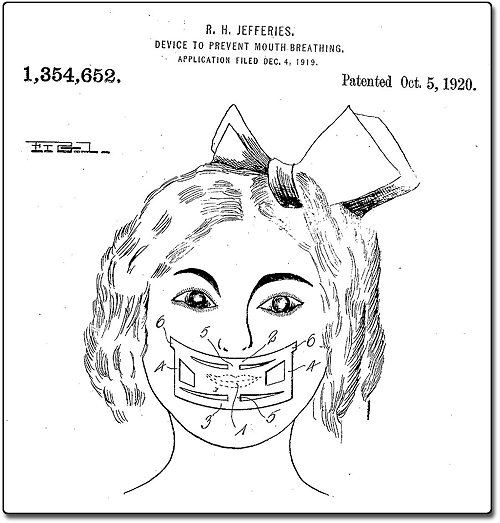
I was vaguely aware that mouth breathing is considered a bad habit, but I wasn't aware that "mouth taping" continues to be a common remedy for it.
For instance, one can buy SomniFix Sleep Strips, which look like they're a slightly updated version of Jefferies' invention.

Posted By: Alex - Wed Oct 27, 2021 -
Comments (1)
Category: Health, Inventions, Patents, 1920s, Face and Facial Expressions
Mask for smokers
Back in 1919, Edward T. Duncan solved the problem of how to smoke and wear a mask at the same time.
Popular Science Monthly - May 1919
The only modern near-equivalent I can find is a mask that jokes about having a "smoke hole," without actually having one.
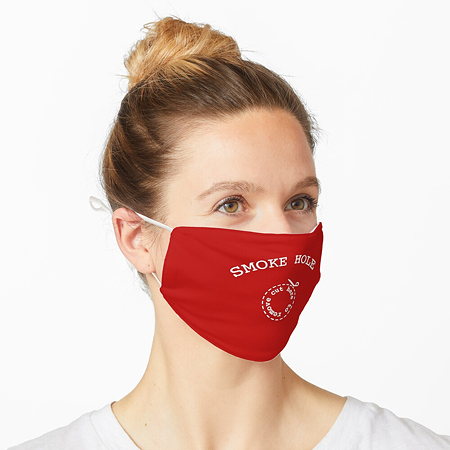
Posted By: Alex - Fri Aug 20, 2021 -
Comments (1)
Category: Health, Smoking and Tobacco, 1910s
Disco Felon
A "disco felon" is a medical condition caused by snapping one's fingers too much to disco music. It was first reported in the New England Journal of Medicine.The original article is behind a paywall, but Edward Nash provided some details in the journal Science Year 1982:
The doctors treated the girl by draining and bandaging the inflammation. She recovered, but Walker and his associates sounded a dire warning to other disco dancers and their doctors. "Disco dancing may eventually be shown to damage a variety of body systems: namely visual, auditory, orthopedic, and nutritional. [Nutritional] damage might result from self-imposed starvation in an attempt... to wear the latest outfits."
A correspondent to the NEJM later suggested that "disco digit" might be a less confusing name for the condition.
Posted By: Alex - Tue Jul 27, 2021 -
Comments (3)
Category: Health, Music, 1970s
Dr. Somers’ Cocaine Cure for Arthritis
Back in the late 1970s, Dr. Lowell Somers, chief of staff at Redbud Community Hospital, made headlines by claiming to have discovered that cocaine could cure arthritis. Somers explained that he discovered this by observing his identical twin cousins, Chuck and Rick. Chuck had arthritis, but Rick didn't. And Rick was a cocaine user, while Chuck wasn't.Somers said he had successfully treated a dozen rheumatoid patients with cocaine. His procedure:

Santa Rosa Press Democrat - Apr 13, 1979
It didn't take long for authorities to shut him down, which they did by charging that he was addicted to demerol and cocaine, and revoking his medical license. I guess he was taking the cure himself. Some info from The Oklahoman:
This sidestepped the issue of whether he may actually have been right about the medical benefit of cocaine for people with arthritis. It doesn't seem entirely implausible to me.
However, some googling pulls up an article suggesting that cocaine use may actually cause rheumatologic conditions. Although the authors admit they're not sure if the cocaine is the culprit, or the contaminants in the cocaine.
On the other hand, there's quite a bit of literature about the potential medical benefits of coca leaves, which people have been consuming in South America for thousands of years. Although coca leaves are a far cry from the pure cocaine Somers was using.

Santa Rosa Press Democrat - Apr 13, 1979
Posted By: Alex - Thu Jul 15, 2021 -
Comments (0)
Category: Drugs, Health, Medicine, 1970s
Hiccup-curing straw (and other hiccup cures)
Researchers have invented a straw that, they claim, will cure hiccups. They call it the HiccAway. From the product page:
Back in 2015, we posted about Hiccupops, invented by 16-year-old Mallory Kievman. These were apple-cider lollipops that, she said, could cure hiccups. Apparently she's done well with her invention, because she's now the CEO of a company selling them.
And here's some more hiccup cures, from an article I wrote for about.com (back when the site still existed):
But in the second half of the 20th century, researchers stumbled upon some less-invasive, but definitely odd, hiccup cures.
The first of these was reported by Dr. Erminio Cardi of Rhode Island in an August 1961 issue of the New England Journal of Medicine. Dr. Cardi had discovered that he was able to cure the hiccups of several patients simply by using a cotton swab to manipulate a hair in their external ear canal. He confessed that this treatment was "seemingly unorthodox," but it worked. He theorized that it did so because the hair had been irritating a nerve that triggered the hiccup response.
And if examination of the ear revealed no hair irritant? No problem. In that case "twirl a stick tipped with cocaine-soaked cotton in the ear," instructed the doctor.
Nowadays doctors are more likely to use lidocaine than cocaine, but the principle remains the same.
The second cure is even more unorthodox, but again, it seems to work. In an August 1988 issue of the Annals of Emergency Medicine, Dr. Francis Fesmire of Jacksonville, Florida reported that a "digital rectal massage" (aka a finger up the bum) had unexpectedly cured a patient of hiccups. Fesmire didn't record what inspired him to think of this technique, but the reason why it worked, he suggested, was similar to the ear method — because it calmed an overactive nerve. Several other doctors have subsequently reported success using this technique.
Posted By: Alex - Thu Jun 24, 2021 -
Comments (4)
Category: Health
Listerine Cigarettes
Another case of an odd brand extension. In 1927, the manufacturer of Listerine debuted Listerine Cigarettes that were infused with the same antiseptic oils used in the mouthwash.The company claimed that these cigarettes would not only "soothe the delicate membranes of mouth and throat," just like the mouthwash, but also that they would "kill 200,000,000 germs in fifteen seconds" and help smokers avoid colds.
As far as I can tell, Listerine Cigarettes remained on the market until the mid-1930s and then disappeared.

St. Louis Post-Dispatch - Dec 12, 1927

Tampa Tribune - Nov 8, 1930
Posted By: Alex - Sat Jun 19, 2021 -
Comments (5)
Category: Health, Cures for the common cold, Smoking and Tobacco
The Blanc Mask
A new face mask that not only filters air but also prevents facial recognition.More info: blancmasks.com, gizmodo


Posted By: Alex - Mon Feb 22, 2021 -
Comments (6)
Category: Fashion, Health
Donald Campbell, the man who couldn’t stop talking
In 1933, Donald Campbell, a truck driver, fell from his truck and hit his head. A year later he developed a bizarre condition. He started talking incessantly, non-stop. His talking was so compulsive that he couldn't even sleep. His talking was perfectly rational. He answered questions clearly. But he couldn't stop.Doctors attributed his condition to encephalitis, or brain swelling. After about a month his non-stop talking subsided, and doctors thought he had recovered. But within four months he was dead. Strangely, the cause of his death was cancer and seemed to be unrelated to his non-stop talking.
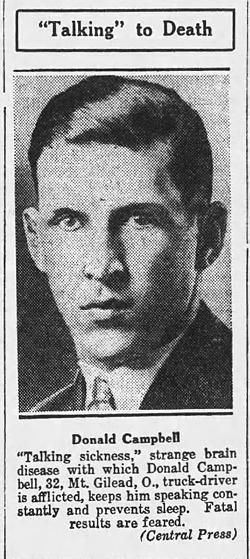
Pottsville Evening Herald - Aug 17, 1934

Pittsburgh Press - Sep 5, 1934

Cincinnati Enquirer - Jan 6, 1935
Update — A newspaper recorded an example of some of Campbell's rambling monologue:
Posted By: Alex - Thu Jan 07, 2021 -
Comments (4)
Category: Health, Mental Health and Insanity, 1930s

| Who We Are |
|---|
| Alex Boese Alex is the creator and curator of the Museum of Hoaxes. He's also the author of various weird, non-fiction, science-themed books such as Elephants on Acid and Psychedelic Apes. Paul Di Filippo Paul has been paid to put weird ideas into fictional form for over thirty years, in his career as a noted science fiction writer. He has recently begun blogging on many curious topics with three fellow writers at The Inferior 4+1. Contact Us |




